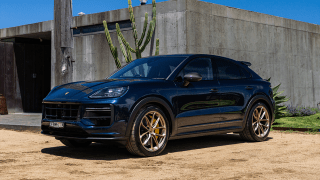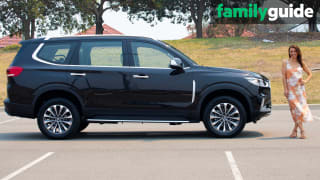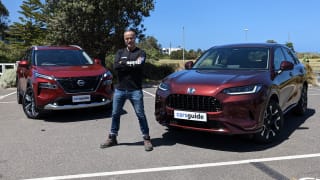It's easy to dream of a world in which all of our transport is free of emissions, and a hyper-fast charging station is positioned on every corner.
In this fictional future we'd surely all be driving electric vehicles — recharged exclusively with renewable energy — and every beachfront, alpine road, remote campsite and, while we're at it, the very top of Mount Kosciuszko, would be home to a bank of fast chargers that are always in perfect working order and miraculously devoid of a slow-moving queue of EVs also waiting to top up.
But as anyone who has driven in Australia lately can tell you, the reality is a little different. The truth is that a battery electric vehicle simply isn't the right choice for everyone, and that's before we get started on the slow rollout of public charging infrastructure.
For one, EVs are comparatively expensive, and potentially budget-blowing for a lot of Australian families.
EVs are also not always suitable for those who cover any real driving distance across the working week, and even less suited to anyone that likes to get right out of town over the weekend — and especially those who like to get back again at the weekend's end.
There's also limited practicality in the current crop of EVs, and they will require a huge charging infrastructure investment to truly unlock the furthest corners of this wide and wonderful land.
So what if you fall into the (pretty broad) camp of people for whom an EV isn't the right fit? What do you do to lower your fuel bills and your emissions, aside from walk?
There is an answer. Plug-in hybrid technology has now begun to arrive in Australia en masse. And for most of us, it's exactly the green answer we actually need.
Why? Because a plug-in hybrid vehicle allows you to travel in electric-vehicle mode whenever you need to, emitting nothing from the tailpipe and burning absolutely no fuel.
And in a good PHEV, you can travel in this silky, silent style for a considerable distance. Take the Mitsubishi Outlander, for example. The Japanese brand helped pioneer plug-in hybrid technology, and it's been resetting the benchmark with each and every new generation.
Which is why the new Outlander Plug-in Hybrid EV can travel a considerable 84km between charges, thanks to its sizeable 20kWh battery. Now stop for a moment and think how much driving you actually do every week. How often would you have to plug in to reduce your fuel bill to zero and to complete all your Monday-to-Friday driving in pure EV mode?
For most of us, the answer is once, or maybe twice, a week. And that's charging at home, usually overnight, and not queued for a public charger. Doing so means all of your weekly transport is done in zippy silence, with the instant torque response and smooth acceleration EVs are known for.
And when you do want to travel further afield, you'll be pleased to hear that public chargers (or, the further you go, the lack of them) again don't feature here.
Instead a plug-in hybrid vehicle like the Mitsubishi Outlander will seamlessly swap to its powerful 2.4-litre four-cylinder petrol engine, and you can simply keep driving, and driving.
And finally, for those who don't like to choose, you can simply let a plug-in hybrid do the thinking for you, choosing when to use the electric motors, the petrol engine, or a combination of both, to maximise your efficiency and range.
Imagine, cross-city commutes in zero-emission silence, and longer road trips that don't require studying a map of public charging stations to figure out how much you can travel between each one. It sounds like the best of both worlds, right? And a driving life free of anxiety, range or otherwise.
Another benefit of a PHEV over a BEV, or battery electric vehicle, is that, because of that petrol-powered back-up plan, the on-board battery pack can afford to be much smaller, and that means much lighter, than in an EV.
And given the battery is often the most expensive part of an EV purchase, that makes PHEVs comparatively cheaper than their all-electric equivalents, too.
But perhaps the biggest perk of all is that you truly get the best of both worlds — a petrol-powered and massively practical vehicle for when you want to get away from it all, find yourself on soccer-training duties, or just have to lug something big home from Bunnings. And a zippy, fun-to-drive EV when you don't.
Or to put it another way, it's zero emission and zero compromise.




.png)




Comments